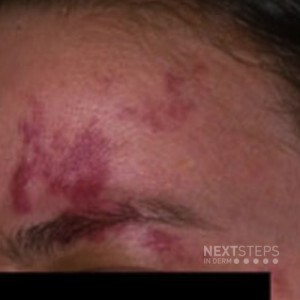
The correct answer is C. Pulse dye laser.
This is a port wine stain and the gold standard of treatment is the pulse dye laser. The long pulse KTP can also be used but it is not the best laser choice.
PDL is useful in the treatment of port wine stains (vascular malformations), superficial hemangiomas and a variety of acquired cutaneous vascular lesions, including telangiectasis, cherry angiomas and poikiloderma of Civatte. Light energy emitted by the flashlamp-pumped PDL is primarily absorbed by oxyhemoglobin contained within blood vessels, thus minimizing thermal damage to other structures. Laser treatment parameters are based on several factors, including lesion location, lesion morphology, and patient skin type. Spot sizes ranging from 2–10 mm are used to deliver a fluence averaging 5–10 J/cm2. The use of larger spot sizes and a higher fluence permits deeper dermal penetration and destruction of larger blood vessels. Lower energy densities are necessary in anatomic locations with an increased risk of scarring, such as the anterior chest, neck, and periorbital area. The physician should apply laser pulses in a nonoverlapping manner to prevent excessive thermal damage (burns) that could result in blistering and scarring.
Port-wine stains treated with the pulse dye laser and a cryogen-cooling device have been shown to have a significantly better response at 585 nm than at 595 nm. In general, port-wine stains fade by 80% after 8–10 treatments. Lesions on the face or neck tend to respond more quickly than those on the lower extremities. For the treatment of port-wine stains, hemangiomas, and facial telangiectasias, the 585 nm pulse dye laser has the best clinical track record for both effectiveness and safety, regardless of patient skin phototype.
References:
Foerster V, Murtagh J, Fiander M. Pulsed dye laser therapy of port wine stains. Technology Report No. 78. Ottawa, ON: Canadian Agency for Drugs and Technologies in Health (CADTH); 2007.
Liu A, Moy RL, Ross EV, et al. Pulsed dye laser and pulsed dye laser-mediated photodynamic therapy in the treatment of dermatologic disorders. Dermatol Surg. 2012; 38(3):351–366.
Tan SR and Tope WD. Pulsed dye laser treatment of rosacea improves erythema, symptomatology, and quality of life. Journal of the American Academy of Dermatology. 2004 Oct; 51(4):592–9.
Komericki P, Akkilic M, Kopera D. Pulsed dye laser treatment of genital warts. Lasers Surg Med. 2006; 38(4):273–276.
Pooja Arora, Rashmi Sarkar, Vijay K Garg, and Latika Arya Lasers for Treatment of Melasma and Post-Inflammatory Hyperpigmentation. J Cutan Aesthet Surg. 2012 Apr-Jun; 5(2): 93–103.
Donelan MB, Parrett BM, Sheridan RL. Pulsed dye laser therapy and z-plasty for facial burn scars: the alternative to excision. Ann Plast Surg. 2008 May; 60(5):480–6.
Treewittayapoom C, Singvahanont P, Chanprapaph K, Haneke E .The effect of different pulse durations in the treatment of nail psoriasis with 595-nm pulsed dye laser: a randomized, double-blind, intrapatient left-to-right study. J Am Acad Dermatol. 2012 May;66(5):807–12
